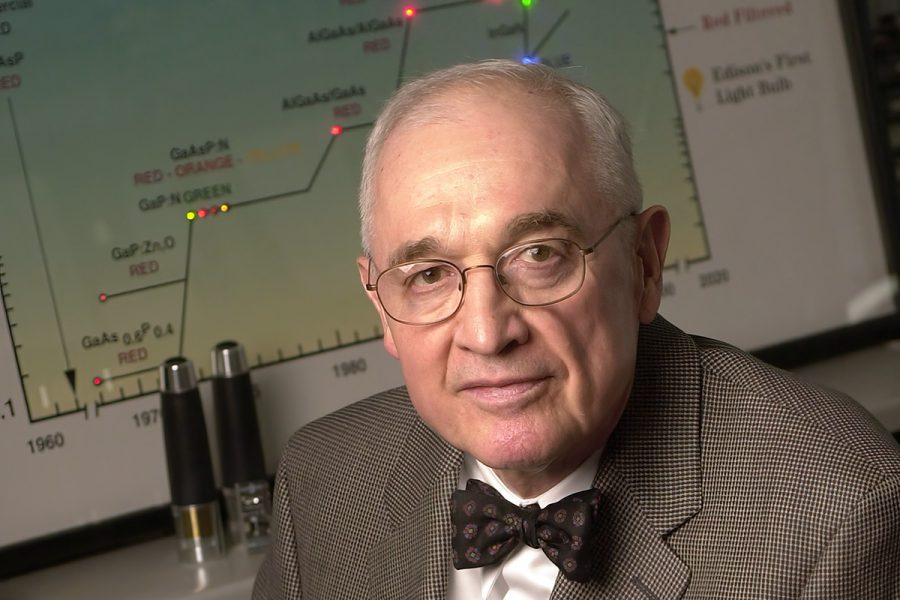LED light innovator Nick Holonyak Jr. dies at 93
Photo courtesy of Bill Wiegand/Illinois News Bureau
Nick Holonyak, researcher and professor in Engineering, died on Sept. 18. Holonyak is well known for his development of the first visible-spectrum LED light.
Sep 26, 2022
Nick Holonyak Jr., a renowned researcher and professor in Engineering, died on Sept. 18 in Urbana, Ill., at age 93. Amid a supremely successful and memorable career, Holonyak is best known for his development of the first visible-spectrum LED light. These LED lights are now used in many facets of daily life, from lightbulbs to device displays such as projectors.
Holonyak was born in Ziegler, Ill., on Nov. 3, 1928. Born into an immigrant family, Holonyak worked on the Illinois Central Railroad before becoming the first in his family to pursue higher education. He received his bachelor’s, master’s and doctoral degrees from the University. He also went on to work for Bell Labs, the U.S. Army Signal Corps and General Electric before joining the University of Illinois faculty in 1963.
During Holonyak’s time working for General Electric, he invented the astounding first visible light-emitting-diode, or LED light, in 1962. Prior to Holonyak’s discovery, LEDs emitted infrared light, a type of light that is not visible to the human eye. The discovery of visible LED lights was particularly revolutionary because of their minimal environmental footprint and long-lasting energy. LED lights not only save money in energy costs but also reduce one’s carbon footprint and contain no mercury.
Milton Feng, the Nick Holonyak Jr. chair professor of Electrical and Computer Engineering, said Holonyak worked hard and lit up the world.
“It’s LED information technology,” Feng said. “There’s no new idea coming out in the next 200 years.”
Get The Daily Illini in your inbox!
After this impactful discovery, Holonyak Jr. dedicated much of his career to optoelectronics, studying how electronic devices can be manipulated to produce visible light.
Feng later developed a technique alongside Holonyak to bend light within gallium arsenide chips. This accomplishment allowed computers to transmit information through light instead of electricity.
“When I was a graduate student, I would witness real breakthrough progress,” Feng said. “When we were in the lab, of course, it raises your standards. He had a vision, which was 10 years ahead of us.”
Additionally, Feng and Holonyak Jr. collaborated to develop the transistor laser, a transistor that emitted both light and electricity to enable future communication technologies.
In 1990, Holonyak was awarded the National Medal of Science by George H.W. Bush. He also received the National Medal of Technology and Innovation from George W. Bush in 2002 and the Queen Elizabeth Prize for Engineering from Queen Elizabeth II in 2021.
Despite these prestigious awards, Stephen Boppart, professor and Grainger distinguished chair in Engineering, was surprised that Holonyak was never a Nobel Prize recipient.
“I think we are, as a faculty and as a University, a bit disappointed that he wasn’t named as a Nobel Prize (winner),” Boppart said. “We thought his work was certainly groundbreaking. But for us that knew him and knew the impact he was making, we understood that it was significant.”
In addition to his many accolades, Holonyak was known for his dedication to his students and generosity toward others.
“I still remember taking his class and, not only the course material, but the way he interacted with students and shared his perspective,” Boppart said. “He (stressed) the importance of mentoring, relationships (and) fundamental science and engineering, but (also) how that could be applied to improve humanity.”
While Holonyak’s legacy will continue to impact engineering students, the Champaign-Urbana community and the world for generations, Boppart hopes he will be remembered as an innovator and a risk-taker, and as someone who inspired his students.
“I think that’s part of his legacy — he recognized the first visible LED, and it’s used in so many devices,” Boppart said. “We see that all the time, everywhere. We love to see that light that he created and left for us.”






